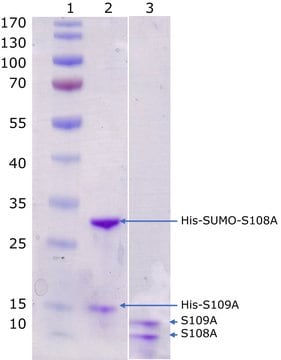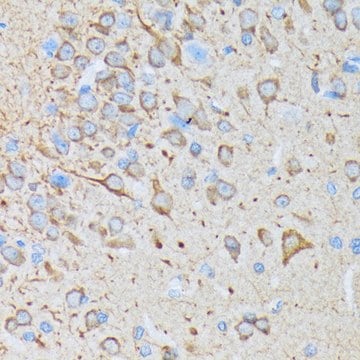ABS2107M
Anti-phospho-CaMKII beta (Ser331)
from rabbit, purified by affinity chromatography
Synonym(e):
Calcium/calmodulin-dependent protein kinase type II subunit beta, EC: 2.7.11.17, CaM kinase II subunit beta, CaMK-II beta
About This Item
Empfohlene Produkte
Biologische Quelle
rabbit
Qualitätsniveau
Antikörperform
affinity isolated antibody
Antikörper-Produkttyp
primary antibodies
Klon
polyclonal
Aufgereinigt durch
affinity chromatography
Speziesreaktivität
rat
Speziesreaktivität (Voraussage durch Homologie)
human (based on 100% sequence homology)
Verpackung
antibody small pack of 25 μL
Methode(n)
immunocytochemistry: suitable
western blot: suitable
Isotyp
IgG
NCBI-Hinterlegungsnummer
UniProt-Hinterlegungsnummer
Posttranslationale Modifikation Target
phosphorylation (pSer331)
Angaben zum Gen
rat ... Camk2B(24245)
Allgemeine Beschreibung
Spezifität
Immunogen
Anwendung
Immunocytochemistry Analysis: A representative lot detected phospho-CaMKII beta (Ser331) in dissociated hippocampal neurons (Kim, K., et. al. (2015). Neuron. 87(4):813-26).
Qualität
Western Blotting Analysis: A 1:500 dilution of this antibody detected phospho-CaMKII beta (Ser331) in HEK293T cells transfected with CaMKII WT, but not the mutant S331A.
Zielbeschreibung
Sonstige Hinweise
Not finding the right product?
Try our Produkt-Auswahlhilfe.
Lagerklassenschlüssel
12 - Non Combustible Liquids
WGK
WGK 1
Analysenzertifikate (COA)
Suchen Sie nach Analysenzertifikate (COA), indem Sie die Lot-/Chargennummer des Produkts eingeben. Lot- und Chargennummern sind auf dem Produktetikett hinter den Wörtern ‘Lot’ oder ‘Batch’ (Lot oder Charge) zu finden.
Besitzen Sie dieses Produkt bereits?
In der Dokumentenbibliothek finden Sie die Dokumentation zu den Produkten, die Sie kürzlich erworben haben.
Unser Team von Wissenschaftlern verfügt über Erfahrung in allen Forschungsbereichen einschließlich Life Science, Materialwissenschaften, chemischer Synthese, Chromatographie, Analytik und vielen mehr..
Setzen Sie sich mit dem technischen Dienst in Verbindung.

![3-[(Trimethylsilyl)ethinyl]pyridin 97%](/deepweb/assets/sigmaaldrich/product/structures/343/531/3049f5ac-7c3c-45ca-b43c-809abc2f3c9d/640/3049f5ac-7c3c-45ca-b43c-809abc2f3c9d.png)






